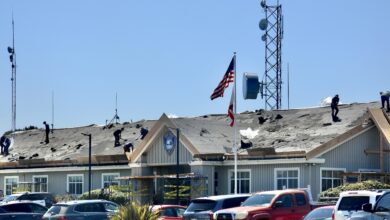MLPAI meeting features maps, data, controversy
Four groups of locals are putting finishing touches on ocean maps that create new areas to restrict fishing but so far exclude most of the Mendocino and Fort Bragg area.
But it”s just a start, actually not even yet the official start of the Marine Life Protection Act Initiative (MLPAI) process.
As the extensive “external” process prepares to give way to the official process on Feb. 1, a “typical” meeting was held Monday night at the C.V. Starr Community Center in Fort Bragg.
As has become usual, there was a brouhaha or two, multiple maps, numerous handouts about the MLPAI process, some late or missing scientific data and a visiting troop of public relations experts, to both explain and dictate terms to locals.
MLPAI Principal Planner Evan Fox answered dozens of questions, dodged others and managed to keep his PowerPoint presentation on track with the help of the PR staff.
The MLPAI staff planned similar meetings later in the week in usually less raucous settings in Eureka and Crescent City.
The MLPAI is a privately-funded and directed effort to create a connected string of new areas closed or restricted to fishing, with the current effort being in the North Coast region, which stretches from just north of Point Arena to the Oregon Border.
Four different local organizations are actively working on “external arrays” which are maps of new areas where fishing would be either banned or restricted — if they ever become reality in any form.
MOCA (Mendocino Ocean Community Alliance), a class from Mendocino High School, a group based in Albion harbor, and Conservation First, several local environmentalists who have broken with MOCA, all intend to present arrays by the Feb. 1 deadline.
Across the three-county region, 18 groups have expressed an interest in submitting an external array. All the energy and ideas will be quickly boiled down into a starting blueprint for the official process.
Monday, the crowd of about two dozen people got to compare the MOCA and Conservation First plans on a giant screen.
All four proposals seek to create a large closed reserve in the Punta Gorda area just south of Cape Mendocino (where a much smaller marine reserve now exists). Under the two compared on Monday, a second fishing restricted area would be located just north of where the Leggett Road (Highway 1) turns inland.
Both MOCA”s and Conservation First”s proposals start just north of the Leggett highway”s coastal end, but the latter”s map is much larger and includes closing fishing off a popular beach area that connects to the Usal Road.
The next restricted area proposed would extend from the Ten Mile Beach area to a state park access just north of Pacific Star Winery and just south of Westport.
While the existing underwater preserve at Point Cabrillo would be expanded in both plans, all the external arrays so far seem to spare most of the area from Elk to Ten Mile.
Dave Wright said the key to the entire MOCA proposal he helped create was reducing the socio-economic impacts by removing closed areas from prime fishing and abalone and urchin diving areas surrounding Fort Bragg and Mendocino.
So far nobody is proposing closures off Fort Bragg. Closures off Caspar and Mendocino beyond simply expanding Point Cabrillo have been discussed but details of those were not presented.
Whatever proposals result, all need to be integrated with proposals from Humboldt and Del Norte counties. This happens under yet another organization invented in the MLPAI process, the Tri-County Working Group.
Next, the entire external array process comes to a screeching halt on Feb. 1, when final external proposals are due. After that, a new organization called the Local Stakeholders Group will be formed, with many of the people involved in groups like MOCA being interested in joining that group, appointed by officials in Sacramento.
This is a new way of doing things for MLPAI staff.
In other regions, external arrays were prepared simultaneously with the work of that region”s official Local Stakeholders Group.
Here, the external process started before the official process and ends with its start. MLPAI staff explained that was done because they expected the number of involved people on the remote North Coast would be insufficient to do both official and external processes at once.
The audience heard details of how arrays don”t “count” unless they pass muster with the work of another group, the Science Advisory Team (SAT). Scientists set up criteria that new arrays must fit in order for that environment to be functional. Distance from shore and composition of the ocean bottom are among the criteria.
For example, for rocky intertidal habitat, there needs to be at least 0.55 linear miles in each new closed area for the habitat replication to “count,” Fox told the crowd.
Also, those preparing arrays can allow certain kinds of extraction activities (fishing, abalone and urchin diving and seaweed harvesting) but if they do the marine protected area won”t “count” for as much as one with fewer fishing activities allowed.
MLPAI staff is waiting for a contractor to finish processing data about the makeup of the ocean bottom, but may not have the data available before the Feb. 1 deadline for submitting external arrays, the crowd heard. This disappointed locals who were waiting for the data to make more intelligent decisions.
The biggest controversy of the night erupted when the PR staff noticed David Gurney videotaping the meeting and asked the crowd if anyone minded being recorded. They said the camera should be turned off if anyone requested it. Two people said they didn”t want to be on tape.
Gurney, who was standing against a wall operating his camera, said it was his right to record a public meeting. A controversy erupted and two uniformed DFG wardens came to assist MLPAI staff.
Gurney has repeatedly objected to the use of wardens as security officers and said they should instead participate in the meeting. He had also been involved in a confrontation at a meeting in Eureka. He blamed the staff for starting the confrontation on Monday, saying it was typical of the extra-legal and illegal efforts of the private MLPAI.
As the situation heated up, this reporter backed up the right of anyone to film a public meeting. A compromise was reached when Gurney agreed not to film people in the audience, although he (correctly) said it was his right to film whatever he wanted at a public meeting (as long as he continued to not disrupt the meeting).
A change is under way in how public relations is handled. Mendocino County now has funding to hire someone local as outreach coordinator, one of the first local jobs generated by the MLPAI effort.
Staff chose not to answer questions from this reporter and Gurney about why the process targets fishing but does not exclude the growing list of ocean industrial uses. The staff said the question was material for a different meeting.
Another question unanswered is why the science data does not focus the problems that that new Marine Life Protected Areas may help solve. A lengthy regional profile document, available for comment online, provides encyclopedic data about the Northern California Coast — although oddly a section on the Mendocino Coast focuses entirely on the Eel River, which flows to sea in Humboldt County.
In answer to the question of why the need for protected areas is not spelled out, the PR staff pointed out the report did contain a list of endangered species. But the factors that made those species endangered along with other species specific information about the good marine life protected areas will do, is missing.
The result is those composing arrays do so without knowing if the fishing they are limiting actually endangers halibut more than groundfish or crabs, or anything at all.
Local resistance to MLPAI dictates has been greater in this region than others. Local cities, counties and harbor districts banded together to protest the process last fall and ask for delays until better science could be presented. Those pleas were ignored but state officials have made changes to the process in response to local activism.
Most importantly, the composition of the Blue Ribbon Task Force has been changed here to actually include two local representatives on an expanded seven-person board. In other regions, industry dominated the BRTF, which makes all the final recommendations for each region. In fact two ocean-harbor developers and an oil lobbyist comprised a majority.
But in the North Coast region, two locals and a Native American activist from Santa Cruz have given the Blue Ribbon Task Force its “greenist” flavor so far.
The local stakeholders group, working with the science advisory team, will recommend one or more arrays to the task force, which will edit that work and then make a final recommendation to the California Fish and Game Commission, which can further edit or pass the new map of protected areas into law.
Conservation First! is a new group on the scene, composed of Bill Lemos, Linda Perkins and others.
Often on the opposite side of the issue is the Albion Harbor Regional Alliance, led by Tomas DiFiore and Mike Carpenter. That group has held meetings and a public event where seaweed gatherers, urchin divers and fishermen offered tastes of their bounty.
MOCA was created by Fort Bragg City Manager Linda Ruffing and Mayor Doug Hammerstrom, who then passed leadership along to others, especially college teacher Jeanine Pfeiffer, who has been acting as moderator.
She emphasizes that locals need to stay involved in the future of the ocean.
“The MLPA process is long, and we are in the initial phase right now ?,” Pfeiffer said. “If we care about the outcome, then we need to continue to be part of the process for the rest of this year, and beyond.”
Draft regional profile: Comments accepted through Friday at www.dfg.ca.gov/mlpa/regionalprofile_nc.asp.




